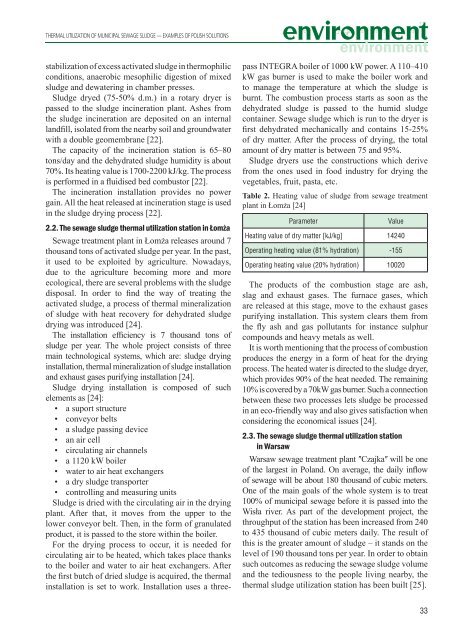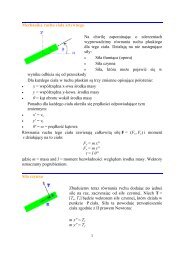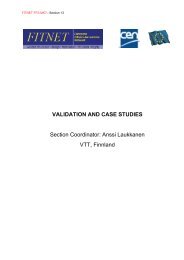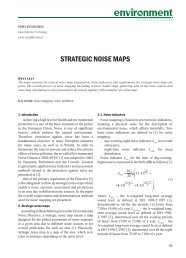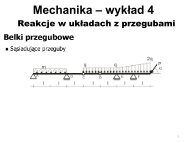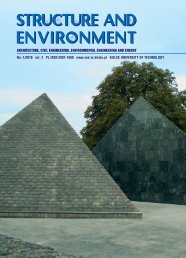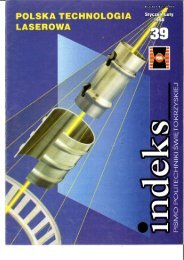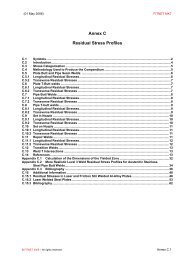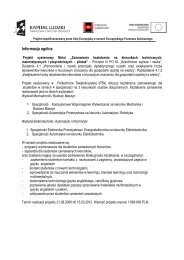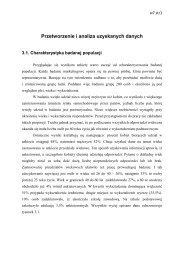STRUCTURE AND ENVIRONMENT STRUCTURE AND ...
STRUCTURE AND ENVIRONMENT STRUCTURE AND ...
STRUCTURE AND ENVIRONMENT STRUCTURE AND ...
Create successful ePaper yourself
Turn your PDF publications into a flip-book with our unique Google optimized e-Paper software.
THERMAL UTILIZATION OF MUNICIPAL SEWAGE SLUDGE – EXAMPLES OF POLISH SOLUTIONS<br />
stabilization of excess activated sludge in thermophilic<br />
conditions, anaerobic mesophilic digestion of mixed<br />
sludge and dewatering in chamber presses.<br />
Sludge dryed (75-50% d.m.) in a rotary dryer is<br />
passed to the sludge incineration plant. Ashes from<br />
the sludge incineration are deposited on an internal<br />
landfill, isolated from the nearby soil and groundwater<br />
with a double geomembrane [22].<br />
The capacity of the incineration station is 65–80<br />
tons/day and the dehydrated sludge humidity is about<br />
70%. Its heating value is 1700-2200 kJ/kg. The process<br />
is performed in a fluidised bed combustor [22].<br />
The incineration installation provides no power<br />
gain. All the heat released at incineration stage is used<br />
in the sludge drying process [22].<br />
2.2. The sewage sludge thermal utilization station in Łomża<br />
Sewage treatment plant in Łomża releases around 7<br />
thousand tons of activated sludge per year. In the past,<br />
it used to be exploited by agriculture. Nowadays,<br />
due to the agriculture becoming more and more<br />
ecological, there are several problems with the sludge<br />
disposal. In order to find the way of treating the<br />
activated sludge, a process of thermal mineralization<br />
of sludge with heat recovery for dehydrated sludge<br />
drying was introduced [24].<br />
The installation efficiency is 7 thousand tons of<br />
sludge per year. The whole project consists of three<br />
main technological systems, which are: sludge drying<br />
installation, thermal mineralization of sludge installation<br />
and exhaust gases purifying installation [24].<br />
Sludge drying installation is composed of such<br />
elements as [24]:<br />
• a suport structure<br />
• conveyor belts<br />
• a sludge passing device<br />
• an air cell<br />
• circulating air channels<br />
• a 1120 kW boiler<br />
• water to air heat exchangers<br />
• a dry sludge transporter<br />
• controlling and measuring units<br />
Sludge is dried with the circulating air in the drying<br />
plant. After that, it moves from the upper to the<br />
lower conveyor belt. Then, in the form of granulated<br />
product, it is passed to the store within the boiler.<br />
For the drying process to occur, it is needed for<br />
circulating air to be heated, which takes place thanks<br />
to the boiler and water to air heat exchangers. After<br />
the first butch of dried sludge is acquired, the thermal<br />
installation is set to work. Installation uses a threepass<br />
INTEGRA boiler of 1000 kW power. A 110–410<br />
kW gas burner is used to make the boiler work and<br />
to manage the temperature at which the sludge is<br />
burnt. The combustion process starts as soon as the<br />
dehydrated sludge is passed to the humid sludge<br />
container. Sewage sludge which is run to the dryer is<br />
first dehydrated mechanically and contains 15-25%<br />
of dry matter. After the process of drying, the total<br />
amount of dry matter is between 75 and 95%.<br />
Sludge dryers use the constructions which derive<br />
from the ones used in food industry for drying the<br />
vegetables, fruit, pasta, etc.<br />
Table 2. Heating value of sludge from sewage treatment<br />
plant in Łomża [24]<br />
Parameter<br />
Value<br />
Heating value of dry matter [kJ/kg] 14240<br />
Operating heating value (81% hydration) -155<br />
Operating heating value (20% hydration) 10020<br />
The products of the combustion stage are ash,<br />
slag and exhaust gases. The furnace gases, which<br />
are released at this stage, move to the exhaust gases<br />
purifying installation. This system clears them from<br />
the fly ash and gas pollutants for instance sulphur<br />
compounds and heavy metals as well.<br />
It is worth mentioning that the process of combustion<br />
produces the energy in a form of heat for the drying<br />
process. The heated water is directed to the sludge dryer,<br />
which provides 90% of the heat needed. The remaining<br />
10% is covered by a 70kW gas burner. Such a connection<br />
between these two processes lets sludge be processed<br />
in an eco-friendly way and also gives satisfaction when<br />
considering the economical issues [24].<br />
2.3. The sewage sludge thermal utilization station<br />
in Warsaw<br />
Warsaw sewage treatment plant ʺCzajkaʺ will be one<br />
of the largest in Poland. On average, the daily inflow<br />
of sewage will be about 180 thousand of cubic meters.<br />
One of the main goals of the whole system is to treat<br />
100% of municipal sewage before it is passed into the<br />
Wisła river. As part of the development project, the<br />
throughput of the station has been increased from 240<br />
to 435 thousand of cubic meters daily. The result of<br />
this is the greater amount of sludge – it stands on the<br />
level of 190 thousand tons per year. In order to obtain<br />
such outcomes as reducing the sewage sludge volume<br />
and the tediousness to the people living nearby, the<br />
thermal sludge utilization station has been built [25].<br />
33


